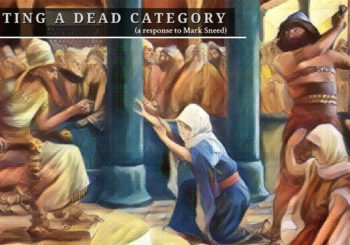Did Ancient Hebrews Have Different Minds than the Greeks?
To answer the above question directly: no.
Last century, a robust debate about the nature of Hebrew mentality (i.e., how they actually thought) eventually became known as the Hebrew-Greek mind problem. Though that debate ended in academia with a fairly definitive loss for those who maintained the Hebrew-Greek dichotomy, it certainly engendered a legacy of thought patterns that extends to today.1The dichotomy is so resilient that even the most current research exploring the body, mind, and senses in biblical epistemology still feels obligated to give a thorough refutation of the two-minds problem. See Michael Carasik, Theologies of the Mind In Biblical Israel (SBibLit 85; Oxford: Peter Lang, 2005), 1–11; Yael Avrahami, The Senses of Scripture: Sensory Perception in the Hebrew Bible (LHBOTS 545; New York: T&T Clark International, 2012), 22–31.
The mid-twentieth century debate focused on this question: Did ancient Hebrews think like we do today? Did they have abstract thoughts? Did they “think about thinking”? Those who answered “no” on this question were verbose. Johannes Pedersen posited that the Israelites, like other ancient cultures, had no embedded construct for thinking and therefore, had no language to discuss a construct which they did not hold. Instead, the Israelite mind could only address things directly perceived. According to this view, the Israelite could not conceive of water qua water, but only of water in a river or puddle. Thus, the Hebrew mind did not abstract:
The Israelite does not occupy himself with empty nor with sharply defined space images. His logic is not the logic of abstraction, but of immediate perception. It is characteristic that the problems treated in the Old Testament are problems pertaining, not to thought, but to life, and that what they seek are not logical results.2Johannes Pedersen, Israel, Its Life and Culture (2 vols.; Oxford: Geoffrey Cumberlege, 1959), I:124.
For Pedersen, the Hebrew mind is marked by the complete fusion of concepts so that a man can only conceive of action and outcome as a unity, not a cause and effect which demands further investigation. For the Israelite, “there is no such thing as ‘good intentions’” because, “the intention or will is identical with the totality of the soul which creates action”:3Ibid., I:132.
For the Israelite—as for primitive peoples generally—the mental processes are not successive, but united in one, because the soul is always a unit, acting in one. But no more are the action and its result to be distinguished from each other or from the mental activities; they are implied in the actual mental process.4Ibid., I:124.
This inability to abstract, argues Pederson, means that ancient Hebrews could not think as we do. Their thoughts are mired, fused in body and action whereas ours can freely range in the abstract world of ideas.
In a similar comparative study, Thorlief Boman develops the contrast between Israelite and Greek thinking using a dynamic/stative dichotomy.5Thorlief Boman, Hebrew Thought Compared with Greek (LHD; London: SCM, 1960). Where Israelites could only think in terms of dynamic action, Greeks harnessed the ability to think of bodies and properties as stative concepts now domesticated by their minds. His examination of Hebrew language looks at elements such as the verbs that describe inner mental states as movement (e.g., “turn my attention to,” “a thought is coming,” etc.).
In making the case, Boman argues that Hebrew thought was fundamentally psychological while Greek thought was logical. Logical, in this sense, consists of the ability to place “ourselves objectively and impersonally outside the matter and ask what is the strict truth about it.”6Ibid., 193. As for the psychological Hebrew mind, “In our psychic life, thinking and understanding are inseparable.” And, “when we would understand a matter psychologically, we familiarize ourselves with it and through sympathetic pursuit of its development we try to grasp it as a necessity.”7Ibid., 193. Thinking, for Boman, is abstract and objective. Yet the ancient Hebrews are associated with somatic ideas of thought from embodied experience. This might seem like an advance toward our thesis, but Boman’s use of “familiar” and “acquaintance” for Hebrew thought is to show why it is not really thinking at all, but reacting to environment.
James Barr’s unfavorable appraisal of these two-mind constructs was definitive. He groups the two-mind proposals by the following properties: 1) contrasts Greek thinking as stative and Hebrew as dynamic, 2) contrasts Greek thinking as abstract and Hebrew as concrete, and 3) contrasts the Greek conception of man as a duality and the Hebrew as unitary being. All of this is based upon the nature of language, the philology of mind in the extant texts of the Hebrew Bible.
Barr’s basic rejoinder aims at the faulty claim that two distinct mentalities can be derived from the languages of the people represented. If Hebrew represents the “verb” mentality and Greek the “noun,” does that dichotomy reflect their mentality per se or the nature of the texts? Barr argues for the latter, pointing out the phenomenological aspect of the extant texts: “The typical vehicle of Hebrew thinking is the historical narrative or the future prediction, both forms of literature in which the verb is likely to be of great significance.”8Barr, Semantics, 15 (see introduction, n. 20). His second major critique points to the vague nature of the comparison itself.
Boman et al. have constructed a theory of mentality that includes their own European mentality and Indo-European language group as the contrast to the Hebrew mentality and Semitic language group. This creates an ineffectual comparison to which Barr raises one penetrating implication. “[I]f the Greek language can be somehow correlated with certain abstract or static features of Greek thought, how is (say) the Albanian language, which is also Indo-European, related with these features?”9Ibid., 18. In short, the two minds analysis is not self-reflected on the analysts themselves, and therefore, it is incomplete.
Later, Julian Jaynes would provide the evolutionary fuel for this discussion in his The Origin of Consciousness in the Breakdown of the Bicameral Mind.10Julian Jaynes, The Origin of Consciousness in The Breakdown of The Bicameral Mind (Toronto: University of Toronto Press, 1976). The basic premise focuses on the two parts of early man’s brain (i.e., bicameral) where one side fires off commands to the other side and it obeys. This work in and of itself enters biblical criticism right at the level of bicameral functions, so that the right side of the bicameral brain is the center of processing voices. Bringing this analysis to the Hebrew text, Jaynes argues that the Hebrew Bible offers the reader a history of the developing mind. Beginning with guidance by hallucinogenic voices from divine beings (e.g., Exod 3), the early human bicameral mind operates by voice. Hence, Moses does what the other hemisphere of his brain, known to him as YHWH Elohim, tells him. Only when consciousness later arises in human beings does the visual command guide humanity and seeing then becomes metaphorical for knowing.
Where we find the ancient person of scripture “hearing” God, according to Jaynes, we are reading about the bicameral human. When humankind reaches consciousness, then we read about people “seeing” what is going on. We cannot review the inherent problems of Jayne’s position here, other than to say that one must accept much more than merely the concept of a bicameral mind, which most scholars do not, in order to bear fruit from such an analysis.11For a critique of Jaynes, see David R. Crownfield, “Consciousness and the Voices of the Gods: An Essay Review,” JAAR 42, no. 2 (1978): 193–202; Carasik, Theologies, 1–14.
Indeed, the basic question needs to be taken up: Did ancient Israelites, as described in the Hebrew Bible and New Testament, think and therefore know like we do? Moreover, do we share any mentality with ancient peoples so that our constructs and language can map onto theirs in a productive way? An affirmative answer is required without hesitation in order to do any broad-ranging analysis of ancient texts. After this, we must then go along with Barr and Carasik to affirm that the biblical languages refer to the same epistemological constructs we have today mutatis mutandis.
If we do share mentality communicated by language, then how does one go about translating the language of Scripture into the common epistemological referents that we share today? Carasik prescribes the study of lexical use within narratives in order to gain an understanding of overlapping language and constructs. For instance, when we say, “He thought X,” we grasp that some biblical authors would state this differently. Some would have understood the heart (לבב) to be the center of thoughts and intent. In looking at those narratives, we do not expect to see language about thinking, but rather the actions of one’s heart. Through building up matrices of the use of specific language with reference to what we call mentality (i.e., epistemology),12Carasik reveals that what he means by mentality is actually something like knowing, thinking, and remembering. Theologies, 11. we can then come to appreciate what writers intended to portray. Carasik is not suggesting that this would be a method for finding hidden beliefs about mentality, but that it becomes the framework to justify any conclusions we may draw from the texts.
If ancient Hebrews did not think as we do, then we can barely claim to have any access to their thinking through the biblical texts. For the above reasons and many more, we reject the absolute dichotomy of Hebrew from Greek thought. This should not be taken as a rejection of Greek thought, as I do not believe that this dichotomy actually captures Hebrew or Greek thought aptly. Instead, I want to suggest that what the Platonic tradition parceled out to the eternal and heavenly realms could be found here in our earthly bodies. We do not lose the benefits of the Hellenistic tradition on my account; only seek to better explain them apart from the heavenly forms.
Though these debates have continued in corridors of academia, it was not until the end of the twentieth century that the body took center stage in various academic discourses, creating an implicit argument that complicates a naïve view of the mind-body schism. The rise of feminist critiques, analogical reasoning, and recent nonverbal psychology gave compelling reasons to regard the body as integral to thinking, to what had previously been considered the domain of abstract Greek thought. We are not merely thinkers who act, but our thinking is shaped by our action and our acts are types of thinking. That embodied thinking is as true in Greek thought as it is in Hebraic thought, making the dichotomy untenable.13See Pierre Hadot’s What is Ancient Philosophy? (Cambridge, MA: Belknap/Harvard University Press, 2004).
This essay is from “The Centrality of the Body for Knowing,” in Knowledge by Ritual: A Biblical Prolegomenon for Sacramental Theology (Eisenbrauns/Penn State University Press, 2016).
Did you enjoy this article? Read more scholarship from the CHT.





